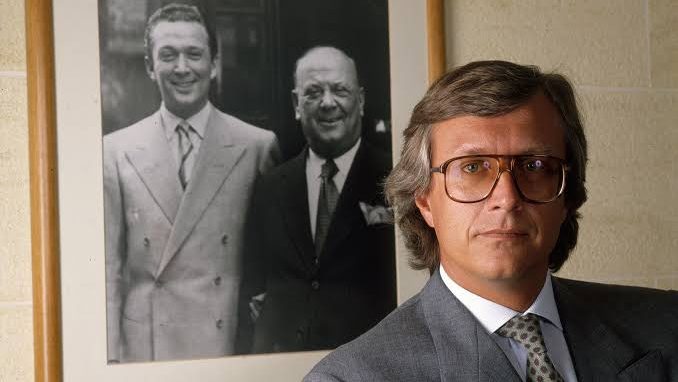
Who Was Maurizio Gucci? A Glimpse into the Fashion Dynasty’s Darkest Chapter

For those quickly seeking answers about Maurizio Gucci, here’s a summary:
- Who he was: An Italian businessman and the one-time head of the iconic Gucci fashion house, grandson of its founder, Guccio Gucci.
- How he died: He was tragically assassinated on March 27, 1995, shot by a hitman. His ex-wife, Patrizia Reggiani, was later convicted of orchestrating his murder.
Want a quick reference? Check out Maurizio Gucci on Wikipedia for an at-a-glance biography before diving into our in-depth New York-focused exploration below.
The name Maurizio Gucci evokes images of Italian luxury, power, and ultimately, a shocking tragedy. Born into one of the world’s most renowned fashion families, his life was a mix woven with threads of immense wealth, ambition, and deep-seated family drama. He was a central figure in the Gucci dynasty, navigating its complexities and steering its course during a pivotal time.
His story, marked by lavish New York City social events and high-stakes business dealings, took a dark turn that would reverberate through the halls of fashion history and true-crime narratives alike. It’s a tale of glamour, betrayal, and a dramatic fall that continues to fascinate readers from Manhattan to Milan.
As R. Couri Hay, a columnist and publicist deeply immersed in high society, I’ve had a front-row seat to how stories like Maurizio Gucci’s captivate and endure. My work, covering the intersection of fashion, wealth, and drama for publications from New York City such as Town & Country and Social Life Magazine, offers an insider’s perspective on this compelling saga.
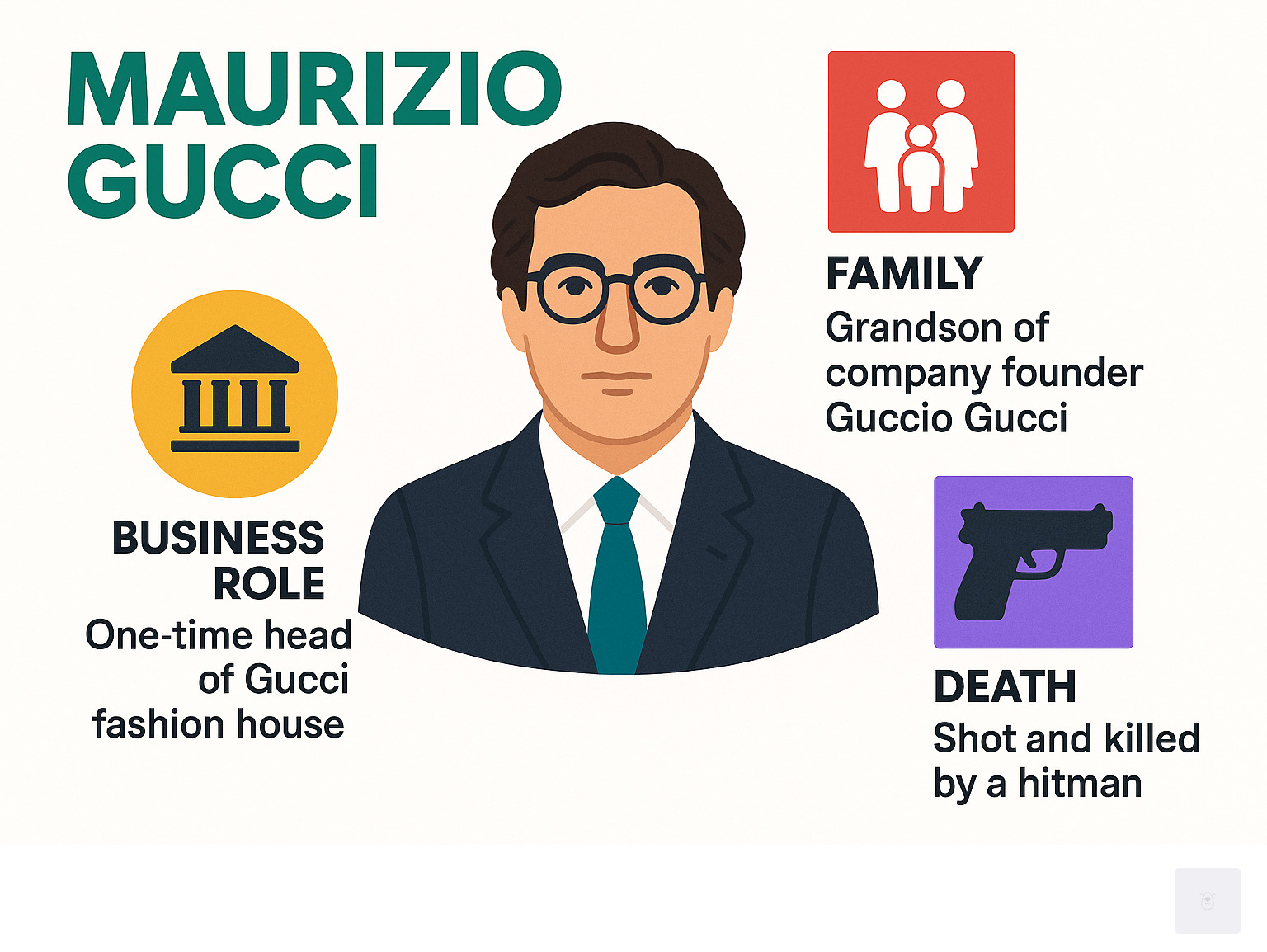
Maurizio Gucci further reading:
The Rise of an Heir: Life in the House of Gucci
Maurizio Gucci was born into luxury on September 26, 1948, in Florence. From his very first breath, he was surrounded by the golden threads of one of fashion’s most prestigious empires. His grandfather, Guccio Gucci, had founded the legendary fashion house in 1921, changing it from a small leather goods shop into a symbol of Italian elegance.
Growing up under the watchful eye of his father, Rodolfo Gucci – a former actor who had traded the silver screen for boardroom drama – Maurizio learned early that the family business was both a privilege and a burden. The Gucci name opened doors, but it also came with expectations that could crush a man’s spirit.
Everything changed in 1972 when Maurizio married Patrizia Reggiani. Their wedding was the kind of spectacular affair that society pages dream about. Suddenly, they weren’t just wealthy – they were the couple everyone wanted to know.
Their lifestyle was breathtaking in its excess. A New York City penthouse served as their American base, where they entertained the city’s elite with parties that became legendary. When winter called, they retreated to their Saint Moritz chalet for skiing and champagne. For summer escapes, there was the “Mauizia” yacht – named after Maurizio himself – where they cruised the Mediterranean like modern royalty.
Patrizia famously declared, “I would rather weep in a Rolls-Royce than be happy on a bicycle.” It wasn’t just a quote – it was their philosophy. In New York City’s high society circles, where image is everything, they understood that success requires both substance and spectacle. Find our branding services in New York City to learn how we help create that kind of unforgettable presence.
Who was Maurizio Gucci?
Maurizio Gucci wasn’t just born lucky – he was born essential. As the grandson of founder Guccio Gucci and the son of Rodolfo, he carried the family’s hopes and dreams on his shoulders. When his father died in 1983, Maurizio inherited a 50% stake in the company, making him the majority shareholder overnight.
By 1989, he had claimed his throne as head of Gucci and chairman of the Gucci group. He was more than an Italian businessman – he was a socialite who understood that fashion is about selling dreams, not just handbags.
But power in the Gucci family came with a price. Maurizio would spend his life navigating family feuds, business battles, and personal demons. His story ended tragically at just 46 years old, but during his time at the helm, he was the living embodiment of everything the Gucci brand represented.
The “Lady Gucci” Era in New York
Patrizia Reggiani was never content to be just a wife – she wanted to be a queen. From the moment she married Maurizio, she set her sights on conquering every social circle that mattered. Her critics, including Rodolfo, dismissed her as a “social climber,” but Patrizia proved she had the ambition and ruthlessness to reach any summit she chose.
As a jet-set couple, Maurizio and Patrizia became fixtures in NYC high society. They didn’t just attend parties – they were the party. Their lavish spending became the stuff of legend, with Patrizia leading the charge in their quest for ever-greater luxury.
Patrizia understood something that many wealthy people miss: money without style is just numbers in a bank account. She pushed Maurizio to dream bigger, spend more, and claim his rightful place as the head of the family empire. Her Gucci’s influence in New York City extended far beyond fashion – she was shaping how America’s elite thought about Italian luxury.
During this golden period, Patrizia wasn’t just married to a Gucci – she was Gucci. The name gave her access to rooms that money alone couldn’t open, and she used every opportunity to cement their status as fashion royalty. Little did anyone know that this glittering era would eventually crumble, taking both their marriage and Maurizio’s life with it.
Power, Betrayal, and the Fall of a Dynasty
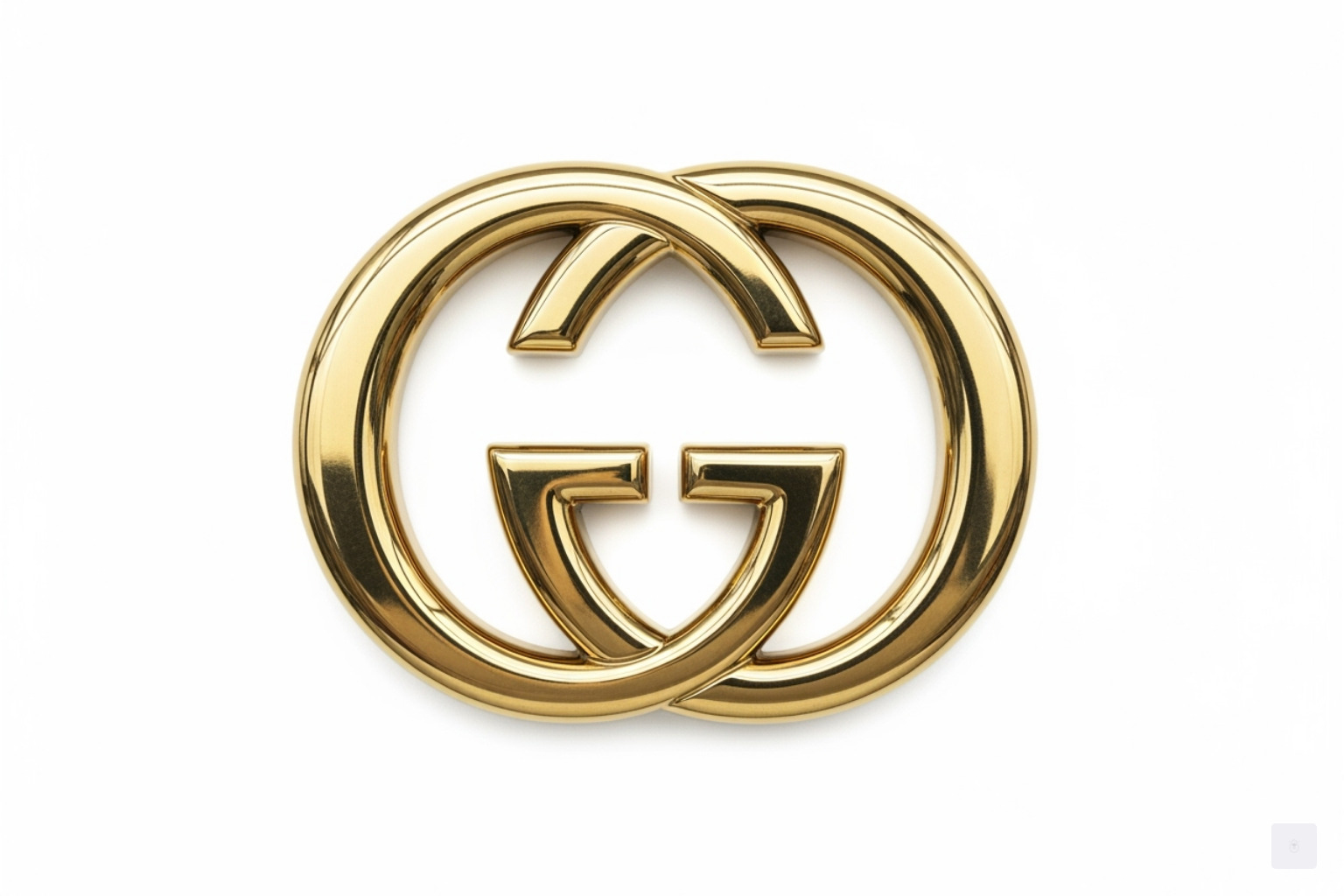
Behind the glamorous facade of the Gucci empire lay a web of bitter family feuds that would make even the most dramatic New York society scandals pale in comparison. The 1980s brought vicious power struggles to the surface, with Maurizio Gucci locked in brutal battles against his own blood.
The main antagonists? His uncle Aldo Gucci and cousin Paolo Gucci. These weren’t polite boardroom disagreements – we’re talking about intense loathing that erupted into physical altercations and public legal battles. The family’s dirty laundry was aired for all to see, complete with accusations of tax evasion and corporate misconduct.
Aldo’s dramatic declaration still echoes through fashion history: “I’m not selling you my shares, but I’m selling you my soul.” It perfectly captured the deep wounds tearing the dynasty apart from within.
Maurizio Gucci found himself drowning in company control issues and mounting debts. Despite his grand ambitions to restore the brand’s prestige, his leadership from 1991 to 1993 pushed Gucci into the red. The irony was crushing – while he continued his lavish lifestyle, the company that funded it was bleeding money and teetering on the edge of bankruptcy.
The Battle for Control
When Maurizio Gucci finally seized control as majority shareholder and chairman of the Gucci group in 1989, it felt like a pyrrhic victory. He had successfully ousted family members, including the formidable Aldo and Paolo, in his quest to streamline operations and restore the brand’s high-end image.
His strategy made sense on paper. The company was suffering from serious over-licensing issues that had diluted the exclusivity of the famous double-G logo. Mass production had cheapened what was once a symbol of ultimate luxury.
But Maurizio’s efforts came at a steep price. The business struggles intensified rather than improved. The weight of carrying both the family name and the future of this luxury empire was crushing him, both financially and personally.
The End of an Era: Selling to New Investors
The financial pressure became unbearable. In 1988, Maurizio made the difficult decision to sell 47.8% of Gucci to Investcorp, an international investment group based in Bahrain.
But that was just the beginning of the end. In 1993, Maurizio Gucci took the ultimate step – he sold his remaining 50% stake to Investcorp for a staggering $170 million. Some sources put the figure between $150 million and $200 million, but regardless of the exact amount, it marked a historic moment.
This sale of shares officially ended the Gucci family’s direct association with the company they had built into a global empire. For a dynasty that had dominated luxury fashion since 1921, it was a heartbreaking conclusion.
The timing couldn’t have been more significant. Maurizio’s divorce from Patrizia was finalized in 1994, just one year before his tragic death. The sale stripped Patrizia of everything she held dear – her status, her financial security, and her identity as “Lady Gucci.”
For businesses navigating such complex transitions and ownership changes, the stakes are always high. These moments require careful strategic planning and expert guidance. Explore our strategic planning services in New York to learn how we help companies and individuals manage these critical turning points.
A Cold-Blooded Murder in Milan
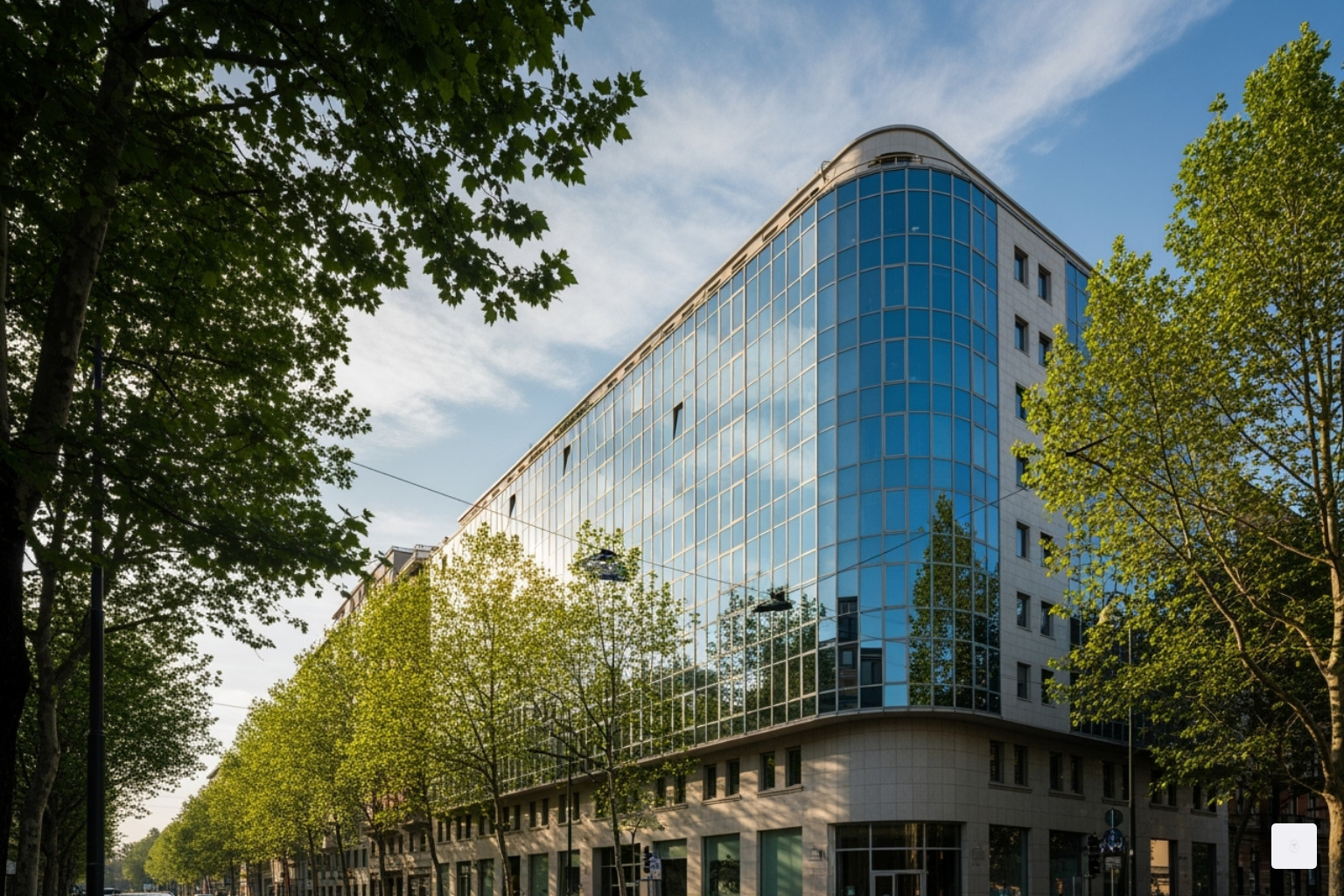
March 27, 1995, started as an ordinary morning in Milan. Maurizio Gucci, dressed impeccably as always, made his usual walk to his office on Via Palestro. At 46 years old, he had survived family feuds, business battles, and financial ruin. But he wouldn’t survive this day.
As he approached the entrance of his office building, a well-dressed gunman stepped forward. The assassination was swift and brutal. Maurizio Gucci was shot four times – three bullets to the back and one to the head. The building’s doorman, Giuseppe Onorato, tried to help but was also shot and wounded in the attack.
Giuseppe held Maurizio as he died on those Milan steps, a heartbreaking end to a life that had been filled with both incredible luxury and devastating betrayal. The news sent shockwaves through the fashion world and high society circles from Milan to New York City.
The Crime Scene: How Maurizio Gucci Was Killed
The killer approached Maurizio Gucci with chilling precision as he climbed the steps to his Milan office that morning. The first shot struck him in the back, causing him to turn around. Two more bullets hit his head, and a final shot ensured the job was complete.
The gunman, described by witnesses as impeccably dressed and calm, walked away from the scene and escaped in a green Renault Clio driven by an accomplice. It was a professional hit, executed with cold efficiency.
The immediate investigation was chaotic. Police considered numerous theories about who might want the fashion heir dead. His tumultuous business dealings had created many enemies. There were questions about mafia involvement and ongoing family feuds within the Gucci dynasty.
The Italian press compared the mystery to the famous “who shot JR” storyline from the American TV show Dallas. Like that fictional character, Maurizio Gucci had accumulated enough enemies during his life of ambition and betrayal to create a long list of suspects.
The End of the Marriage
The roots of this tragedy stretched back to the bitter collapse of Maurizio Gucci’s marriage to Patrizia Reggiani. Their separation in 1985 was as dramatic as their lavish lifestyle had been. Maurizio simply packed an overnight bag one day and never returned home. He sent a friend to tell Patrizia he wouldn’t be coming back from his business trip.
The divorce was finalized in 1994, just one year before his death. By then, Maurizio had found love again with Paola Franchi, a woman he had known since childhood. This new relationship became another source of rage for his ex-wife.
Patrizia felt completely stripped of her identity and status. The woman who had once declared she’d “rather weep in a Rolls-Royce than be happy on a bicycle” was now facing a future without the Gucci name or fortune. She saw Maurizio’s relationship with Paola as a direct threat to her daughters’ inheritance.
Her resentment boiled over into threatening behavior. She sent Maurizio tape recordings where she called him a “monster” and warned that “the inferno for you is yet to come.” When offered her alimony settlement, she dismissed it as “a mere bowl of lentils,” showing just how deep her anger ran.
This toxic mix of financial insecurity, wounded pride, and jealousy would prove deadly. Patrizia’s fury over losing her place in the Gucci world had created a motive that would soon shock even the jaded observers of high society drama.
The Black Widow’s Web: Solving the Assassination of Maurizio Gucci
The murder of Maurizio Gucci was a shocking puzzle that stumped investigators for a long time. But nearly two years later, an anonymous tip changed everything. Suddenly, police found themselves looking at the most unlikely suspect: his ex-wife, Patrizia Reggiani. As prosecutors would later argue, her reasons were a powerful mix of intense jealousy, a thirst for money, and deep-seated resentment. She quickly earned a chilling nickname in the Italian press: “Vedova Nera” – the Black Widow. This dramatic title echoed across news desks, even captivating true crime fans in New York City.
The big break in the case came when an informant, Ivano Savioni, a hotel porter who had helped set up the hit, got greedy. He tried to extort more money from Patrizia. Police, ever so clever, set up a sting operation. They recorded conversations that not only implicated Patrizia but also her accomplices. It was a dramatic turn in a high-profile case that grabbed headlines from Milan all the way to New York.
The Conspirators and Their Motives
Patrizia Reggiani definitely didn’t act alone. She was the mastermind, but she pulled the strings with the help of several others. There was Pina Auriemma, Patrizia’s trusted confidante and psychic, who acted as the go-between. Then came Ivano Savioni, the hotel porter who helped connect Auriemma with the hitman. Orazio Cicala was the getaway driver for that fateful day. And finally, Benedetto Ceraulo, a pizzeria owner, was the one hired to be the hitman.
Patrizia reportedly spent over 600 million lire on the assassination, which was about 300,000 euros back then. When she was asked about the cost, her reply was chillingly blunt: she said it “was worth every penny.” Her desperate need to regain control and prevent Maurizio Gucci from remarrying and possibly changing his will pushed her to seek a hitman. She even brazenly admitted during her trial, “I was asking everyone, it was an obsession, I would have even asked my butcher!” A truly incredible statement that showed just how far she was willing to go.
The Trial and Aftermath
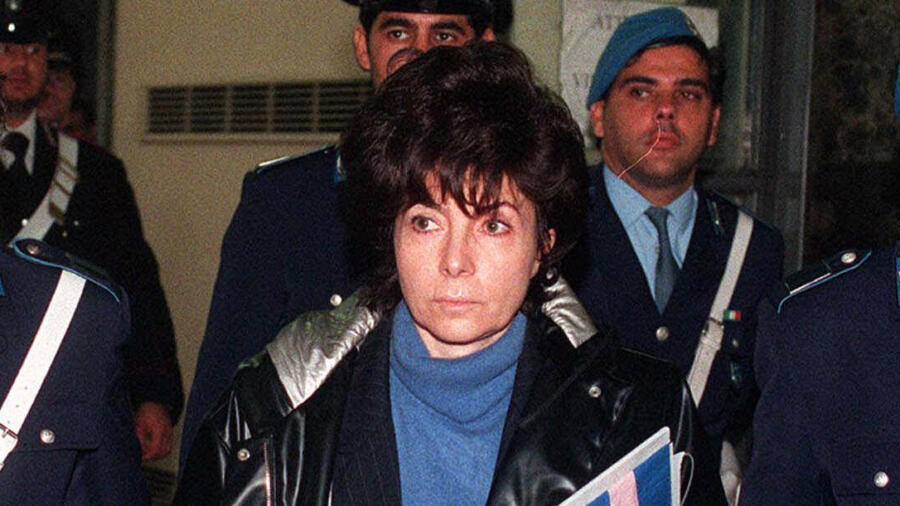
The trial of Patrizia Reggiani and her accomplices began in 1998, drawing immense media attention from around the globe. Patrizia was found guilty of arranging the killing and was sentenced to 26 years in prison. (It was originally 29 years, but later reduced.)
Her time behind bars was as quirky and unique as her public life. She famously referred to her incarceration as “my stay at Vittore Residence” – quite the upgrade from “prison”! She was even allowed to keep a pet ferret named Bambi in her cell. In 2011, she made headlines again when she famously refused day parole. Her reason? “I’ve never worked in my life, I’m certainly not going to start now.” However, she eventually did get out, released in October 2016 after serving 18 years.
Even after her release, Patrizia remained a captivating figure. She was often spotted strolling through Milan with a macaw perched on her shoulder. And when someone dared to ask why she didn’t shoot Maurizio Gucci herself, she quipped, “My eyesight is not so good—I didn’t want to miss.” The dispute over her alimony continued for years, a clear sign of her enduring connection to the Gucci fortune and name.
From Scandal to Screen: The Gucci Legacy in Popular Culture
The dramatic and tragic story of Maurizio Gucci and Patrizia Reggiani was ripe for popular culture adaptation. It first captured widespread attention in Sara Gay Forden’s 2001 book, “The House of Gucci: A Sensational Story of Murder, Madness, Glamour, and Greed.”) This book laid the groundwork for what would become a major cinematic event, cementing the Gucci legacy not just in fashion, but in the annals of true crime and high society scandal, captivating audiences from Milan to New York City. Our team, with our deep understanding of how such narratives capture public imagination, often works with clients to shape their stories for maximum impact. If you’re looking to tell your story effectively, we invite you to Learn about our publicity services in NYC.
House of Gucci: The Film
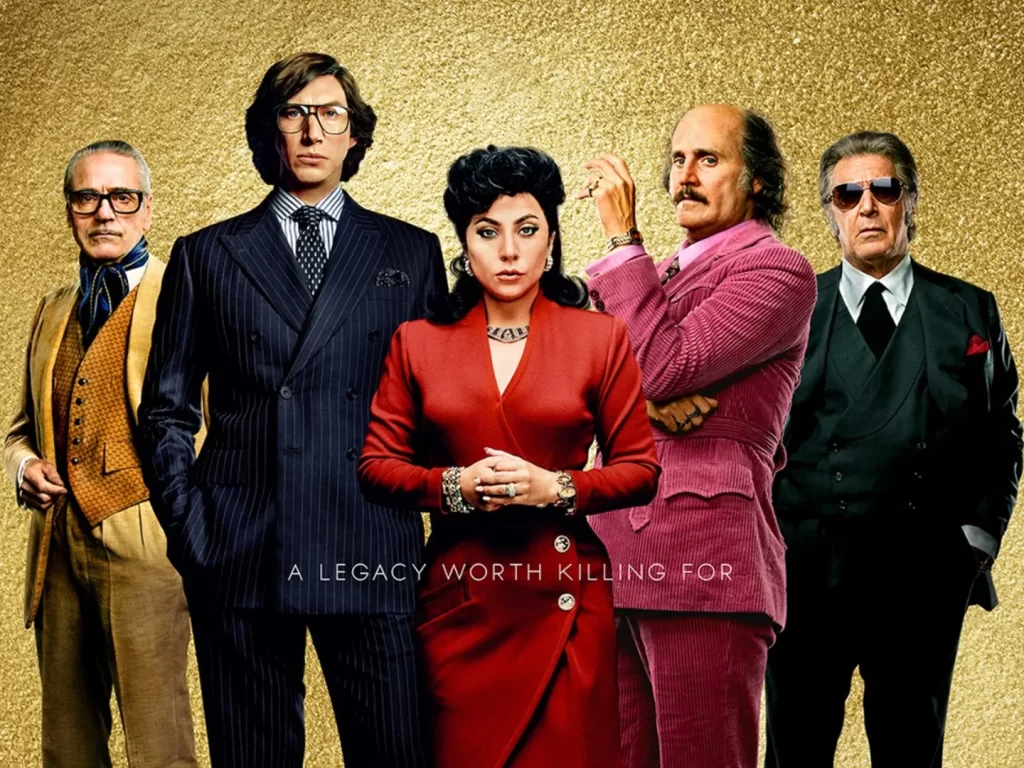
MGM / courtesy Everett Collection.
In 2021, Ridley Scott brought the story to the big screen with the film “House of Gucci.” The movie boasted an all-star cast, with Lady Gaga delivering a powerful performance as Patrizia Reggiani and Adam Driver portraying Maurizio Gucci. The film also featured Al Pacino as Aldo Gucci, Jared Leto as Paolo Gucci, and Jeremy Irons as Rodolfo Gucci.
The film received a mixed critical reception, with some praising the performances, particularly Gaga’s and Leto’s, while others criticized its narrative choices and pacing. Jared Leto’s portrayal of Paolo Gucci, with his quirky mannerisms and exclamations of “Boof!”, became a memorable, albeit divisive, element. Adam Driver’s change from a “dimply, bashful smirk” to a “cold-hearted, back-stabbing entrepreneur” as Maurizio was widely noted. Lady Gaga’s Patrizia was seen by many as an accurate “replica” and “reimagining” of the real-life figure. The film’s use of vintage music, including a French cover of “I’m a Believer,” also added to its distinct aesthetic.
Family and Fashion World Reactions
The release of “House of Gucci” stirred significant reactions, especially from the surviving Gucci family members. They issued a public statement, expressing their disappointment and calling the portrayal an “insult to the family,” citing inaccuracies in the depiction of events and characters. Allegra Gucci, Maurizio and Patrizia’s daughter, even released her own book, “Game Over,” in 2022, offering her perspective on the tumultuous family history.
Within the fashion world, the film sparked renewed commentary on the Gucci dynasty’s complex history. Reflections from New York’s fashion scene often revolved around the enduring allure of the brand, despite the dark chapters of its past. It served as a reminder that even the most glamorous empires can harbor deep-seated conflicts and tragic outcomes.
Conclusion: The Enduring Legend of a Fashion Tragedy
What a wild ride it’s been through Maurizio Gucci! His story isn’t just a tale from the fashion pages; it’s a captivating true-crime saga that truly has it all. From his birth into one of the most famous fashion families to his shocking, untimely death, Maurizio’s life perfectly shows us the intoxicating pull of immense wealth, the drive of ambition, and the heartbreaking sting of betrayal. He was a man who bravely tried to steer a struggling empire, but in the end, he lost control of not just his business, but his very life.
The themes woven throughout his narrative – greed, power, love, and ultimately, murder – continue to grab our attention, pulling us in like a magnetic force. The public’s fascination just doesn’t fade, fueled by the sheer audacity of the crime and the larger-than-life personalities involved. It’s a powerful cautionary tale, reminding us that even within the most glamorous circles of high society, deep human emotions can lead to the most devastating and unforgettable consequences.
Here at R. Couri Hay Columns, we truly understand the power of stories like Maurizio’s. Our commentary often dives into that intricate dance between what the public sees and what’s truly happening behind closed doors. We love offering exclusive, entertaining insights into high society events and the captivating tales that shape them. The Maurizio Gucci tragedy serves as a vivid reminder of just how quickly fortunes and reputations can change. Especially in busy metropolises like New York City, where every move is watched, managing one’s public narrative isn’t just important—it’s absolutely crucial. For those navigating such complex and often public waters, our expertise can be an invaluable guide. You can Learn more about our crisis management PR services in New York.

